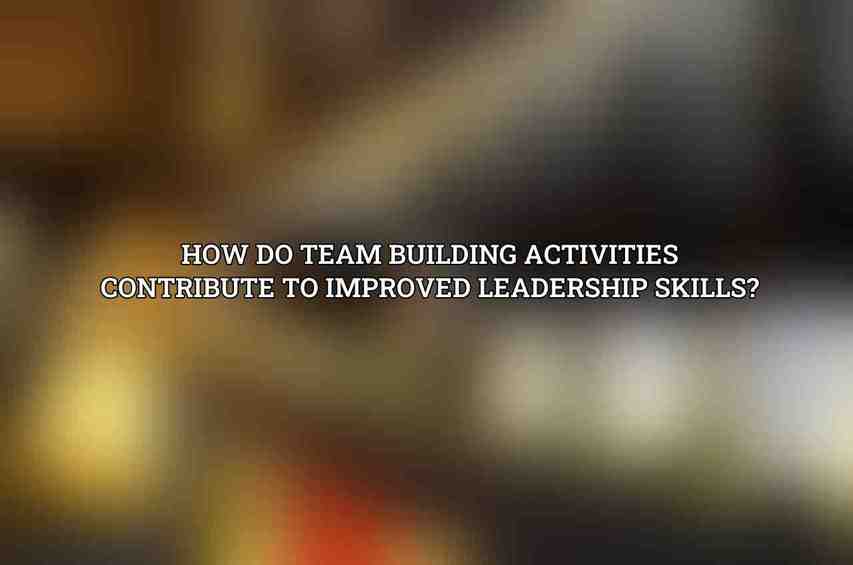Team building is a crucial component of effective leadership, fostering collaboration, communication, and trust among team members. By engaging in structured activities that promote teamwork and problem-solving, leaders can enhance their ability to lead effectively. Implementing team building activities is essential for leadership development as it not only strengthens relationships within teams but also improves motivation, productivity, and overall performance.
The benefits of incorporating team building activities for leadership development are manifold. These activities help leaders identify and leverage the strengths of team members, improve communication skills, and foster a culture of innovation and creativity. By engaging in experiential learning through team building exercises, leaders can enhance their emotional intelligence, empathy, and decision-making capabilities, leading to more cohesive and high-performing teams.
Innovative Team Building Activities for Leadership
A. Escape Rooms
Escape rooms provide immersive and interactive environments that require participants to solve puzzles, communicate effectively, and work together as a team to escape within a set time limit. These activities promote critical thinking, time management, and collaboration among team members. Some examples of escape rooms tailored for leadership skills development include:
| Escape Room | Description |
|---|---|
| The GameXcape | Offers themed rooms with puzzles designed for leadership skills |
| The Escape Game | Hosts rooms focused on fostering collaboration and decision-making |
B. Virtual Scavenger Hunts
Virtual scavenger hunts are digitally hosted activities that engage participants in solving riddles, completing challenges, and exploring virtual environments. These hunts promote problem-solving, creativity, and teamwork while allowing remote teams to bond and communicate effectively. Examples of platforms offering virtual scavenger hunts for leadership development include:
| Platform | Description |
|---|---|
| GooseChase | Allows creation of customizable hunts with GPS challenges for remote team engagement |
| Let’s Roam | Offers pre-designed hunts exploring local landmarks for team building and bonding |
C. Simulations and Role-Playing
Simulations and role-playing activities provide participants with realistic scenarios to practice leadership behaviors and decision-making under pressure. These activities help leaders develop skills such as adaptability, conflict resolution, and strategic thinking. Examples of effective simulation tools for leadership development include:
| Tool | Description |
|---|---|
| The Leadership Challenge | Facilitated simulations for structured leadership development |
| Role-Playing Activities | Assigns specific leadership roles to participants for skill practice |
D. Adventure-Based Activities
Adventure-based activities involve physical challenges that require teamwork, communication, and problem-solving. These activities build trust among team members, encourage risk-taking, and promote a sense of accomplishment. Examples of adventure-based activities for leadership development include:
| Activity | Description |
|---|---|
| Rock Climbing | Builds trust and communication as team members support each other during the climb |
| High Ropes Courses | Challenges participants to overcome fears and build confidence through teamwork |
E. Case Studies and Discussions

Analyzing real-life leadership scenarios through case studies helps participants apply theoretical knowledge to practical situations. Group discussions and reflections on these cases encourage critical thinking, decision-making, and sharing of diverse perspectives. Some resources for leadership case studies and discussions include:
| Resource | Description |
|---|---|
| Harvard Business Review Case Studies | Offers a range of real-life leadership challenges for analysis |
| Leading with Purpose | Facilitates discussions on leadership principles and their applications |
Facilitating and Assessing Team Building Activities
Successful implementation of team building activities for leadership development requires careful planning, effective facilitation, active participant engagement, and thorough evaluation. Key considerations for facilitating and assessing team building activities include:
- Planning and Design Considerations: Tailoring activities to meet specific leadership development goals and team dynamics.
- Facilitator’s Role and Responsibilities: Creating a supportive environment, guiding discussions, and encouraging participation.
- Participant Engagement and Feedback: Ensuring active involvement, fostering communication, and soliciting feedback for continuous improvement.
- Evaluation and Measurement Techniques: Using metrics, surveys, and observations to assess the impact of team building activities on leadership development.
innovative team building activities play a vital role in shaping effective leadership by enhancing collaboration, communication, and problem-solving skills among team members. These activities not only strengthen relationships and trust within teams but also contribute to improved performance, creativity, and morale. By engaging in a variety of experiential exercises like escape rooms, virtual scavenger hunts, simulations, adventure-based activities, and case studies, leaders can develop essential leadership capabilities and drive organizational success.
The impact of these team building activities on leadership development is substantial, leading to more resilient, adaptive, and empowered leaders who can navigate challenges and inspire their teams effectively. To continue fostering leadership growth, it is recommended that organizations integrate a mix of these innovative activities into their leadership development programs, tailor activities to the specific needs of their teams, and provide ongoing support and feedback for continuous improvement. By investing in team building activities, organizations can cultivate a culture of strong leadership and achieve sustainable success in a rapidly evolving business world.
Frequently Asked Questions
What are some innovative team building activities for effective leadership?
Some innovative team building activities for effective leadership include escape rooms, outdoor team challenges, cooking classes, and team project competitions.
How do team building activities contribute to improved leadership skills?

Team building activities promote communication, teamwork, problem-solving, and trust among team members, which are essential skills for effective leadership.
How can team building activities benefit the overall performance of a team?
Team building activities can improve collaboration, morale, and motivation among team members, leading to increased productivity and better overall team performance.
Are virtual team building activities as effective as in-person activities?
Virtual team building activities can be just as effective as in-person activities when facilitated well, utilizing technology and creativity to foster strong connections and collaboration among team members.
What are some key considerations when planning team building activities for leadership development?
When planning team building activities for leadership development, consider the goals of the activity, the preferences and needs of team members, the desired outcomes, and the resources available to ensure a successful and impactful experience. Find out about Top Leadership Training Courses to Empower Your Management Skills 2024

